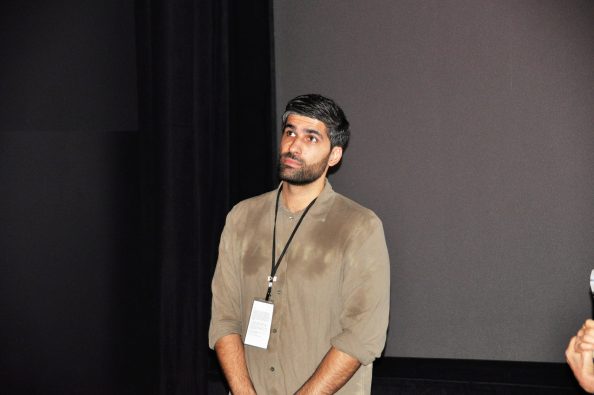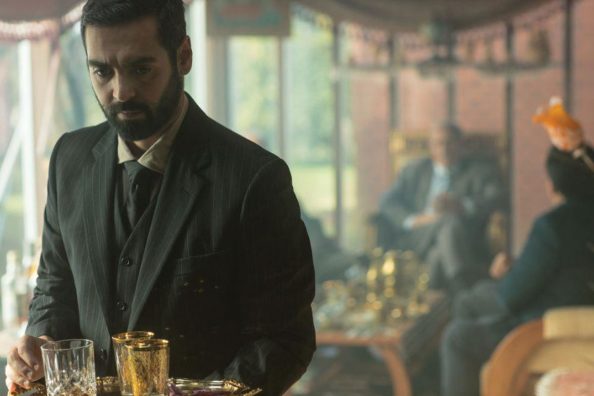The Chicago International Film Festival announced winners of many awards, celebrating the films chosen by the Festival juries in various categories on October 20th, 2017. Among those selected for awards were two foreign films that definitely impressed me: “The Charmer” from Denmark by Iranian born first-time director Malad Alami won the Silver Hugo and “Killing Jesus,” which won the Roger Ebert Award for Colombian director Laura Mora. (Malad Alami moved to Sweden from Iran at the age of 6).
THE CHARMER

Iranian-born director Milad Alami (Sweden since age 6) with the Danish film that won the Silver Hugo at the 53rd Chicago International Film Festival on October 20th, 2017. (Photo by Connie Wilson)

Silver Hugo winner “The Charmer” from Denmark, directed by Milad Alami starring Ardalan Esmaili as Esmail.
This film from Denmark was actually about the practice of Iranian men who come to Scandinavian countries (in this case, Denmark) and attempt to find a Danish female citizen who will either (a) marry them, so that they can stay in the country or (b) agree to support them, so that they can stay in the country. Apparently, this happens quite often and, in this case, the good-looking and polite young man who is attempting to strike gold by trolling the bars of Denmark is Esmail.
As The Charmer opens, Esmail is in a semi-relationship with a young woman and living with her, but she has just asked him to move out, saying, “You’re suffocating me. I don’t really know you.”
Esmail responds, “We’re good together, aren’t we?”
His companion in bed says, “We’re good at this, but that’s not enough.”
Esmail learns soon after that, if he cannot file a “Letter of Cohabitation” with the authorities, he will be sent back to Iran.
Also, in his travels from bar to bar in search of a new woman, Esmail meets a tall, thin Danish man who says, “They’re looking for someone like you. I’m more of a meat and potatoes kind of guy.” The two keep meeting in this fashion until the Danish man offers to give Esmail a ride home to his tiny, depressing rented room. When they arrive at the destination, the Danish citizen reveals that his wife, Anna, had been one of Esmail’s sexual conquests and she has subsequently committed suicide by jumping from a window when the affair ended. The husband (now her widower) is obviously devastated.
At this point, I expected a standard murder story, but things become even more interesting, as Esmail—now being completely honest about his tenuous status in Denmark—-meets a young girl, Sara, who is of Iranian parentage, but was born in Denmark and is currently studying law. She lives with her mother, a famous singer, Leila Kazemi, who is highly regarded in the Iranian community.
Sara and Leila Kazemi invite Esmail both to a large Persian party and to their home for dinner. Mother Laila even gifts Esmail with one of the suits that belonged to her dead husband. He is present at a large party they are giving, where the guests all make the assumption that this is Sara’s boyfriend and that they make “a handsome couple.” Leila has weighed in on Esmail’s status problems saying, “What a shame. I really like him. He’s very polite. He’s got intelligent eyes. I’m sure he’ll do well if he’s allowed to stay.”
When Sara (the daughter) asks Esmail what he thought he would find in Denmark when he emigrated from Iran, he responds, “I could never have imagined you.” The implication is quite clear: Sara really likes Esmail and Esmail is falling for Sara.
But the path of true love never runs smoothly.
The director, Malad Alami, who was present at the screening, explained how he talked to many people who had experienced this deception or perpetrated it themselves. Find a gullible woman—perhaps a sexually-starved one—be very considerate and attentive and see if that wins you a ticket to life in Denmark.
Alami spoke about how Esmail “can’t really do this.” He is too honorable to misrepresent himself this way. Esmail is also horror-struck (and frightened) when Anna’s husband accosts him and begins stalking him.
The lead part of Esmail was one that Alami did extensive casting for, auditioning between 150 to 175 men. He ended up hiring an actor he has known for a long time, Ardalan Esmaili, who, he said, “has this kind of sensitivity and innocence, but also a lot of darkness.” This was his Esmaili’s first feature film, as it was, also, Alami’s first directorial feature.
Alami did a wonderful job telling this interesting story, so much so that his film won the Silver Hugo on October 20th at the Awards Ceremony.
KILLING JESUS

Paula (Natasha Jaramilla) and Jesus (Giovanny Rodriguez) in “Killing Jesus,” the first film from Colombian director Laura Mora. (Colombia/Argentina)
When you read the write-up in the program regarding Director Laura Mora’s film “Killing Jesus” (Matar a Jesus) you see where the plot will go. “Two men on a motorcycle: shots are fired; another man is left dead on the ground. Paula’s father has been assassinated.” Paula got a good look at the hit man on a motorcycle.
Paula (Natasha Jaramillo) is a typical dreamy college student. The victim, her father, was an admired professor who advocated for unpopular but democratic ideals. The law offers no answers. With revenge in her sights, Paula desperately sets out to find her father’s killer.
By chance, she meets him—dancing, smiling—at a nightclub. The two grow closer. His name is Jesus. He wants to be with her. She wants to get close to him.
So, the plot is inherently rife with conflict as Paula (Natasha Jaramillo) learns more about the man who shot and killed her father (Giovanny Rodriguez).
I found that it helped to have watched the television series “Narcos” to really understand the extent of the criminal element in Colombia and that the message of the movie, ultimately, was that Paula and Jesus were both victims. Jesus is not such a “bad guy,” when Paula gets to know him, but his life in Colombia is completely limited by the unfettered crime of the city and he is simply a pawn in a much-larger criminal enterprise.
The thing that set this film apart was the chemistry of the two leads and the backdrop of the city of Medellin. There was some very nice cinematography (James L. Brown) that showed Medellin spread out below, viewed from a “secret spot” that Jesus takes Paula to, since she is a student of photography.
The director (Laura Mora) shared that she wanted to work with non-professional actors who were from Medellin because their manner of speaking would be more authentic. The two do a good job and, although there are a few jerky camera shots, the cinematography by James L. Brown was very good.
All-in-all, I was very happy that both “The Charmer” and “Killing Jesus” left Chicago with some of the recognition that each film deserves.























